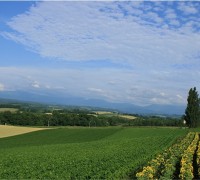Most tourists visiting Sapporo or Hokkaido look forward to experiencing fresh and delicious local food. There are many varieties to choose from such as the authentic Japanese full course of Kaiseki featuring seasonal ingredients; Youshoku, the a la carte western dishes that were established in Japan after the introduction of Western cuisine at the dawn of the modernization era; and the budget-friendly, so-called “B-grade gourmet” foods that the Japanese locals love and enjoy a lot.
However if visitors are on some sort of diet restrictions (e.g. Muslim, vegetarian, vegan, etc.), the number of eating and drinking establishments and food-related stores in which they can eat or buy food without worrying is still quite limited, especially in Hokkaido.
When a tour guide is around, the guests can be easily assisted, but on a free day, or outside the day’s tour schedule, they are only by themselves. Therefore, just in the hope of maximizing their opportunities of satisfying their wish of trying what Japanese locals eat even without a guide around, I came to think that a small card explaining that he/she is in need of a little help from a Japanese speaking person, and having them carry it, could be of some use.
For example, “Spaghetti Napolitan”, a popular Youshoku a la carte dish, or Yakisoba, stir-fried noodles flavored with a savory sauce resembling Worcestershire sauce, are old favorites of people in Japan. These foods are often displayed at the restaurant’s entrance, in the form of resin-made food samples (which are also a unique Japanese invention). These colorful and appetizing food models are intended to visually appeal to hungry and/or first-time customers. Overseas visitors may have seen them in pictures in travel magazines or guidebooks and want to try them once they’re in Japan.
However, both of these foods contain pork or pork-derived ingredients in addition to some chopped vegetables.
In the case of buying processed or pre-packed food, a smartphone app can translate the Japanese writing on the package and the ingredients’ label into the language of their choice right on the spot. However, some guests may not be so good at using these devices and/or they may want to double-check with someone to make sure if it’s really ok to buy or eat it.
So here’s what I prepare and distribute to my guests:
It’s a piece of paper, preferably brightly colored. One side (suppose it’s side A) is a message they can use when buying prepared food, and the other side (side B), is a message they can use when at an eating establishment.
Side A
1) Point(s) to take note
2) Unwanted items
3) Both answers: “They are in (don’t buy)” and “Not in (ok to buy)”, in both Japanese and English
For example, in case of Muslim guests
1) Halal only:*ハラル対応が必要です(*イスラム教の食のルール)
2) NG材料:食べられないもの、ダメなもの:
・Pork and pork-derived ingredients 豚肉ソーセージ、ベーコン、ラードや皮革を含む豚(肉)加工品
・Alcohol 、アルコール
3) Answers to be pointed at (答えを指して下さい)
使われています:Haram, don’t buy it
使われていません:Halal, ok to buy it
I prepare some cards only with the format on the first day of the tour and, upon request, after confirming with the guests, I complete Side A 1) and 2) information by handwriting.
Side B
Intended when the guest would like to ask if the order he/she would like to place can be cooked without the items written in 2) on side A.
Yes, we can (はい、できます)
・ For here/Eat in (店内で)
・ To go/ Take away (持ち帰りで)
We’re sorry, we cannot.
(すみません、できません)
This card, when folded in half, is made into the size of a business card so that it can be put in a wallet/purse together with cash or credit cards. It is easy to show it to a Japanese speaking person who seems kind and not so busy (this is an important point!) Using the card can be much faster than using a translation app.
I have given this card to a considerable number of guests, but so far I haven’t done any research on how often it was used during his/her stay or how successful the communication was. However, some guests have voluntarily given me positive feedback with thanks, including a remark like “the shopper (or the shop clerk) to whom I talked was really kind and helpful.”
This is only a tiny and simple gesture, but considering the fact that the local food is one of the most important attractions in tourism, I would like to continue this practice hoping that it would help my future guests enjoy their time in Sapporo or Hokkaido in a more carefree manner.
K
RELATED ARTICLES
-
The Odori Park in Sapporo
-
Double-flowered cherry tree are beautifully blooming.
-
The spectacular night view of Sapporo
-
Marimo at Lake Akan
-
What is a trip for kids?
-
Beautiful Japanese Crane Tancho in Kushiro, Eastern Hokkaido
-
Ecorin Village in Eniwa: A Town of Flowers and Ecology
-
Pleasurable Farming Tours in Hokkaido
-
Experience Contemporary Ainu Art at the Foot of Mt.Hakkenzan
-
The present-day Ainu and Iomante -from the story of th...

















